ISMA presents production of the institute. On this page one can find information about next positions
- ALPHA DETECTORS ZnSe BASED
- ALPHA/BETA DETECTORS
- ZnSe (O,Al) SCINTILLATION CRYSTALS FOR X-RAY
- POLYSTYRENE BASED SCINTILLATION DETECTORS
- POLYSTYRENE BASED PLASTIC SCINTILLATION MATERIALS
- BISMUTH GERMANATE Bi4Ge3O12 (BGO)
- RARE-EARTH GARNETS (YAG:Ce, LuAG:Ce)
- STRONTIUM IODINE SrI2:Eu CRYSTALS AND DETECTORS
Advantages ZnSe vs ZnS(Ag) power: no phosphorescence, lower afterglow
| Scintillator | ZnSe (O,Al) |
| Production’s form | - powder (granule size is up to 15 mkm) |
| - one part paint | |
| - tiles of single crystal connected with light guide from polymethyl methacrylate (PMMA) | |
| MeasurementrRange of surface activity | 239Pu 3.4∙10-3 – 3.4 103 Bk∙cm-2 |
| Sensitivity to 239Pu | >0,15 cps/(particle∙min-1∙сm-2) |
| Energy range | 2000-10000 keV |
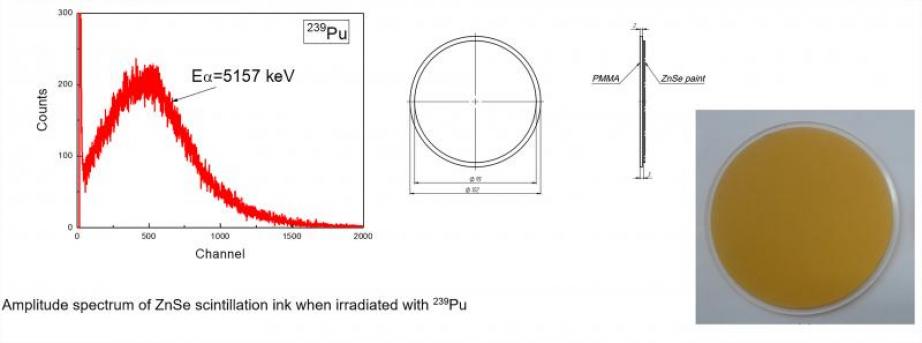
ZnSe(O,Al) vs ZnS(Ag)
| Parameter | ZnSe(Al,O) | ZnS(Ag) |
|---|---|---|
| Morphology | single crystal, polycrystalline powder | polycrystalline powder |
| λmax, nm | 590 | 450 |
| Light yield, photon/MeV | 70000 | 75000 |
| Decay time, ns | 1000 | 200 |
| Afterglow, % (after 3 ms) | 0.5 | 20.6 |
| α/γ ratio | 0.8 | - |
Alpha detectors are used for particle detection in radioecology and technological control.
Advantages: spectrometric for α and α/β separation, no phosphorescence large area production technology.
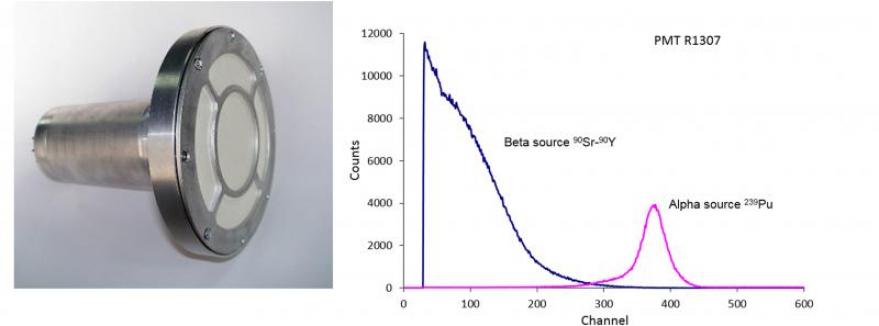
| Scintillator | ZnSe (O,Al) |
| Scintillator’s active area | |
| - single crystal | up to 2” |
| - “mosaic” design | more than 2” |
| α/γ ratio (239Pu, 137Cs) | 0.84 |
| Registration efficiency (4π), 239Pu | 35% |
| Sensitivity, pps∙Bq, 239Pu | > 0,3 |
| Sensitivity, pps∙Bq, 90Sr-90Y | > 0,27 |
| Minimum detecting activity, Bq, 239Pu | < 0,02 |
| Minimum detecting activity, Bq, 90Sr-90Y | < 0,15 |
| Energy range: | |
| Alpha | 2000-10000 keV |
| Beta | 65-4000 keV |
Advantages: low afterglow, high efficiency for x-ray energy.
| Scintillator | LO, % | Afterglow, % | |||||||
| 3 ms | 5 ms | 10 ms | 20 ms | 30 ms | 100 ms | 200 ms | 500 ms | ||
| ZnSe fast | 50 | 0.003 | 0.003 | 0.002 | 0.001 | 0.001 | 0.001 | 0.001 | 0.000 |
| ZnSe standard | 100 | 0.022 | 0.016 | 0.009 | 0.006 | 0.004 | 0.001 | 0.001 | 0.000 |
| ZnSe flexible | 40 | 0.085 | 0.071 | 0.051 | 0.041 | 0.035 | 0.021 | 0.014 | 0.008 |
| GOS (Pr) fast | 53 | — | — | 0.008 | — | 0.005 | 0.002 | — | — |
| GOS (Pr) slow | 53 | — | — | 0.08 | — | 0.02 | 0.01 | — | — |
| CsI(Tl) | 100 | 0.718 | 0.501 | 0.332 | 0.288 | 0.261 | 0.193 | 0.155 | 0.106 |
| Zeff | 33 |
| Density, g/cm | 35.27 |
| Cleavage plane | <100> |
| Hardness, Mhos | 4 |
| Hygroscopic | No |
| Wavelength of emission max, nm | 590 |
| Lower wavelength cutoff, nm | 460 |
| Refractive index @ emission max | 2.66 |
| Effective average decay time for γ, μs | 0.8 |
| Light yield for γ, photon/keV | 60 |

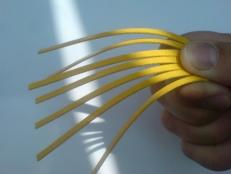
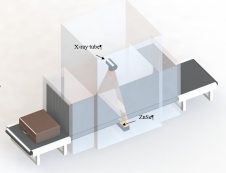
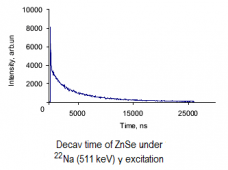
Gamma detectors for radiation portal monitors are used for gamma-energy registration from 15 KeV.
Advantages: cost efficient, high uniformity and low-gamma radiation sensitivity.
| Scintillator | Polystyrened based |
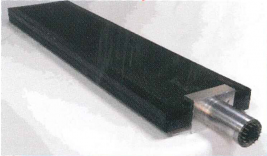 |
| Cross size | up to 2000 mm | |
| Operating temperature | – 40°C … +60°C | |
| Wavelength (max emission) | 418 nm | |
| Decay time | 2.4 ns | |
| Light output | 56% |
| scintillator | size | sensitivity, 1/sec*kBq |
MDA,1/kBq |
||
| Cs137 | Am241 | Cs137 | Am241 | ||
| more than | no more than | ||||
| PS | 50x500x1000 | 10 | 1,2 | 40 | 250 |
| PS | 50x250x1000 | 5 | 0,7 | 50 | 300 |
| PS | 50x406x1880 | 3 | 0,5 | 65 | 400 |
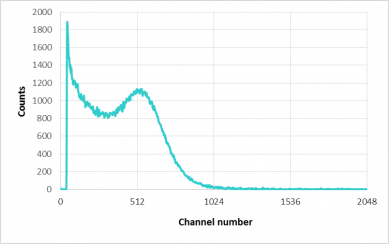
ISMA offers following polystyrene based scintillation materials:
BISMUTH GERMANATE Bi4Ge3O12 (BGO)
Scintillation and physical properties
| — Polystyrene based plastic scintillators UPS-923A |
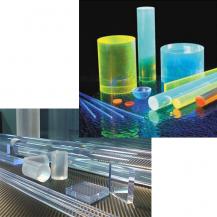 |
|
|
418 | |
|
2, 3 | |
|
1.55 | |
|
56 | |
| — Wavelength shifting plastics | |
|
from 425 to 530 (in accordance with customer's requirements) |
| — Radiation-hardness | |
|
530 |
|
7 |
| — Plastic scintillators for neutron-gamma discrimination UPS-113 NG | |
| Wavelength (max emission), nm | 418 |
| Decay time, ns | 2, 3 |
| Reflective index (@430 nm) | 1.55 |
| Light output, % of anthracene | 42 |
| n/ϒ discrimination | 1.8 |
| — High temperature | |
|
up to +120°C |
BISMUTH GERMANATE Bi4Ge3O12 (BGO)
|
Transmission of BGO 3 mm thick
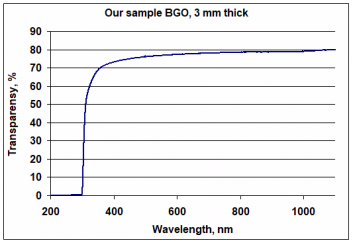 |
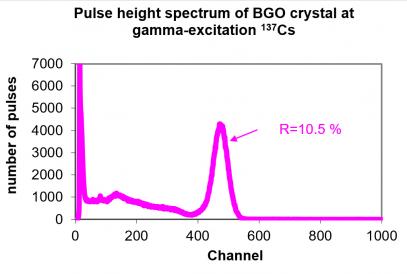 |
Scintillation and physical properties
| Effective atomic number | 75.2 |
| Density, g/cm3 | 7.13 |
| Melting point, К | 1323 |
| Radiation length, cm | 1.12 |
| Refractive index | 2.15 |
| Luminescence peak, nm | 480 |
| Hygroscopicity | no |
| Decay time, ns | 300 |
| Light yield, ph/MeV | 8000-10000 |
| Light yield, % (Nal:TI) | 15-20 |
| Energy resolution (662 keV), % | 10.0-12.0 |
| Afterglow, % (after 3 ms ) | 0,005 |
| Radiation hardness | + |
High stopping power, high scintillation efficiency, good energy resolution, non-hygroscopicity made BGO the material of choice for high energy physics, nuclear physics, space physics, nuclear medicine, geological prospecting and other industries.
ISMA supplies high quality BGO crystal boules of up to 76 mm dia., or up to 300 mm long, as well as elements of various shapes.
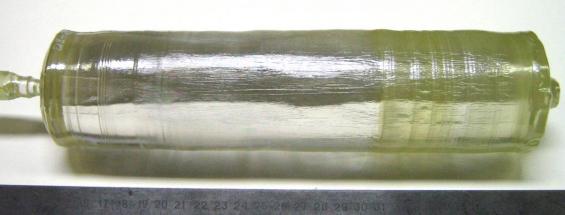 BGO 60 mm dia.
|
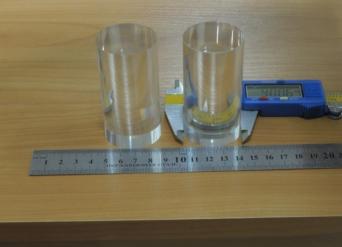 |
Yttruim aluminium garnet Y3Al5O12:Ce (YAG:Ce), Lutetium Aluminum Garnet and solid solution ((Lu,Y)3Al5O12) activated by cerium (Lu3Al5O12:Ce, LuAG:Ce), are fast and bright scintillation materials. The decay time is 70-100 ns. This is of advantage in time dependent and coincidence measurements. The wavelength of scintillation emission is about 530-550 nm, which is ideal for photodiode and avalanche diode readout. LuAG is a good alternative to dense and fast rare-earth orthosilicate scintillators (LSO:Ce, GSO:Ce, LYSO:Ce). The material is mechanically and chemically stable with no cleavage and hygroscopicity. The material can be machined into a variety of shapes and sizes including prisms, spheres and thin plates.
Scintillation and physical properties
| YAG:Ce | LuAG:Ce |
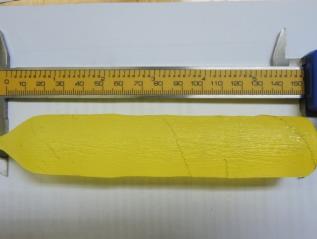 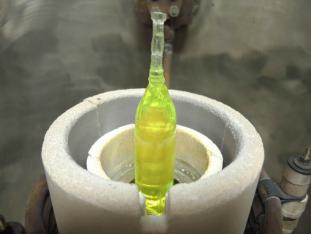 |
||
| Crystal size available | up to 45 mm dia. and 150 mm length | |||
| Crystal structure | cubic | |||
| Cleavage | no | |||
| Hygroscopicity | no | |||
| Light yield, ph/Mev | 30000 | 27000 | ||
| Hardness, Mhos | — | 8.5 | ||
| Emission | 550 nm | 535 nm | ||
| Density, g/cm3 | 4.55 | 6.7 | ||
| Refraction index | ~ 1.8 | ~ 1.8 | ||
| Primary decay time, ns | 50-100 | 60 | ||
| Advantages - Good radiation hardness (YAG:Ce); - High density (LuAG:Ce); - Good matching for photodiode and avalanche diode readout; - Very good machining properties; - Fast decay. |
Main usage - High energy gamma and charged particle detection; - PET matrices; - High spatial resolution imaging screens for X-rays, gamma and beta. |
STRONTIUM IODINE SrI2:Eu CRYSTALS AND DETECTORS
Scintillation and physical properties
| Effective atomic number | 49.4 | SrI2:Eu is one of the most efficient scintillators with excellent light yield and energy resolution. The energy resolution up to 3.2 % at 662 keV makes this scintillator very efficient for spectroscopic determination of nuclear isotopes. We offer both naked crystals, and their encapsulation preventing oxidation at open air. |
| Density, g/cm3 | 4.6 | |
| Melting point, °C | ~600 | |
| Radiation length, cm | 1.95 |
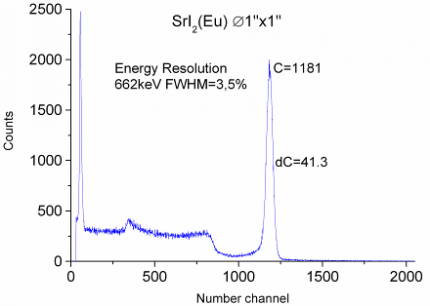 |
| Refractive index | 1.85 | |
| Luminescence peak, nm | 435 | |
| Hygroscopicity | yes | |
| Decay time | ~1 µs | |
| Light yield, ph/MeV | 80000 | |
| Energy resolution (662 keV), % | up to 3.2 | |
| Non-proportionality of light yield in the 20-1500 keV range | <10% |
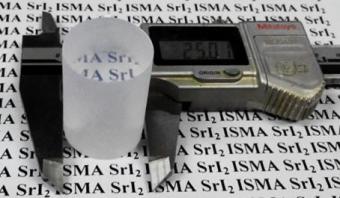 25 dia. x 35 mm element |
 25 mm dia. x 25 mm dia. elements |
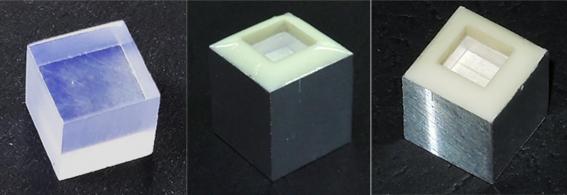 Naked and encapsulated 6x6x6 element |
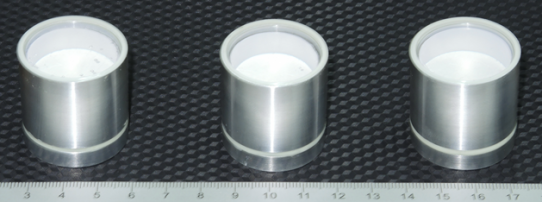 Encapsulated 25 mm dia. 25 mm elements |
